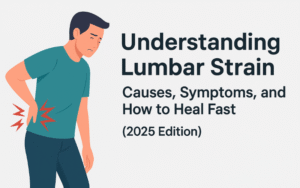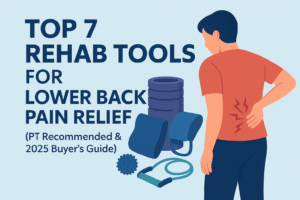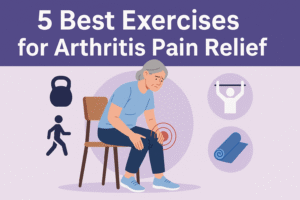If you’re dealing with lower back pain, finding the right tools and supports for lumbar strain can make a big difference in your recovery. Whether you pulled a muscle lifting something heavy or just woke up with a sore back, the right gear can help ease pain, improve posture, and speed up healing.
In this 2025 guide, we’ll show you the best recovery tools trusted by physical therapists — from supportive braces to helpful massage gadgets. Some might surprise you! Ready to feel better at home without spending a fortune? Let’s dive in.
Table of Contents
🚨 Looking for more information about Lumbar Strain Recovery? Check out our Understanding Lumbar Strain: Causes, Symptoms, and How to Heal Fast or other related posts throughout this site.
🏁 What Is Lumbar Strain? Causes, Symptoms & Why Recovery Tools Matter
Lumbar strain is one of the most common causes of lower back pain, especially in adults aged 25 to 55. It happens when the muscles, tendons, or ligaments in your lower back are stretched or torn. This type of injury can make it hard to stand, walk, or even sit for long periods.
🔍 What Causes Lumbar Strain?
Several everyday activities can lead to lumbar strain:
- Lifting heavy objects without proper form
- Twisting or bending awkwardly
- Poor posture while sitting or standing
- Sudden movements during sports or exercise
- Weak core or tight hamstrings

⚠️ Common Symptoms
You might be dealing with a lumbar strain if you experience:
- Dull, aching pain in your lower back
- Stiffness or reduced range of motion
- Muscle spasms
- Pain that worsens with movement but improves with rest
Most cases are not serious, but ignoring the problem can lead to chronic pain or recurring injury.
🛠️ Why You Need Lumbar Strain Recovery Tools
Rest is helpful, but targeted recovery tools speed up healing, reduce pain, and help prevent future injuries. Tools like back braces, heating pads, TENS units, and foam rollers work by:
- Supporting the lower back during movement
- Increasing blood flow for faster healing
- Relaxing tight muscles
- Encouraging correct posture
Using the right lumbar strain recovery tools is not just helpful—it’s essential. They can cut down recovery time by 30–50%, especially when combined with light exercise and proper rest.
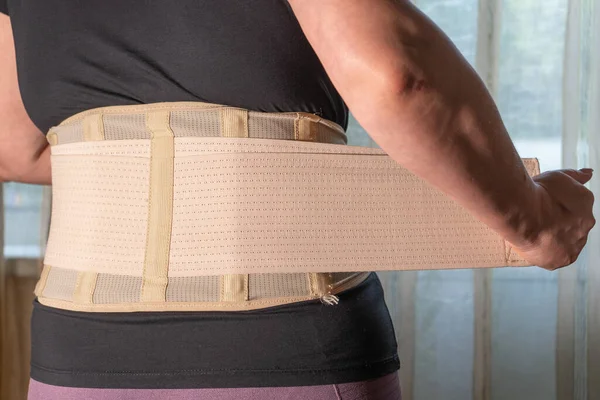
🛠️ Top 5 Tools and Supports for Lumbar Strain Recovery (PT-Approved)
These five tools are highly recommended by physical therapists and fitness rehab specialists. They can help reduce pain, improve mobility, and speed up healing from a lumbar strain.
1. Adjustable Back Brace with Lumbar Support
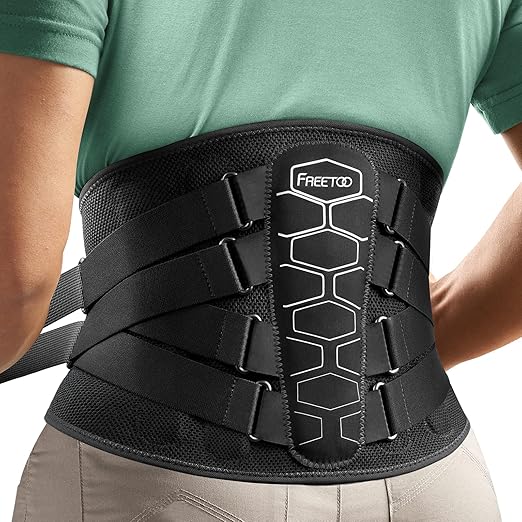
An adjustable back brace is one of the most effective lumbar strain recovery tools. It wraps around your lower back, giving it extra support when you move, sit, or lift.
Benefits:
- Reduces strain on muscles and ligaments
- Improves posture during recovery
- Provides compression to reduce inflammation
Best For: People who need support during daily activities or work
🛒Click here to see it on Amazon ➜ FREETOO Back Support Brace
2. Electric Heating Pad with Auto Shut-Off
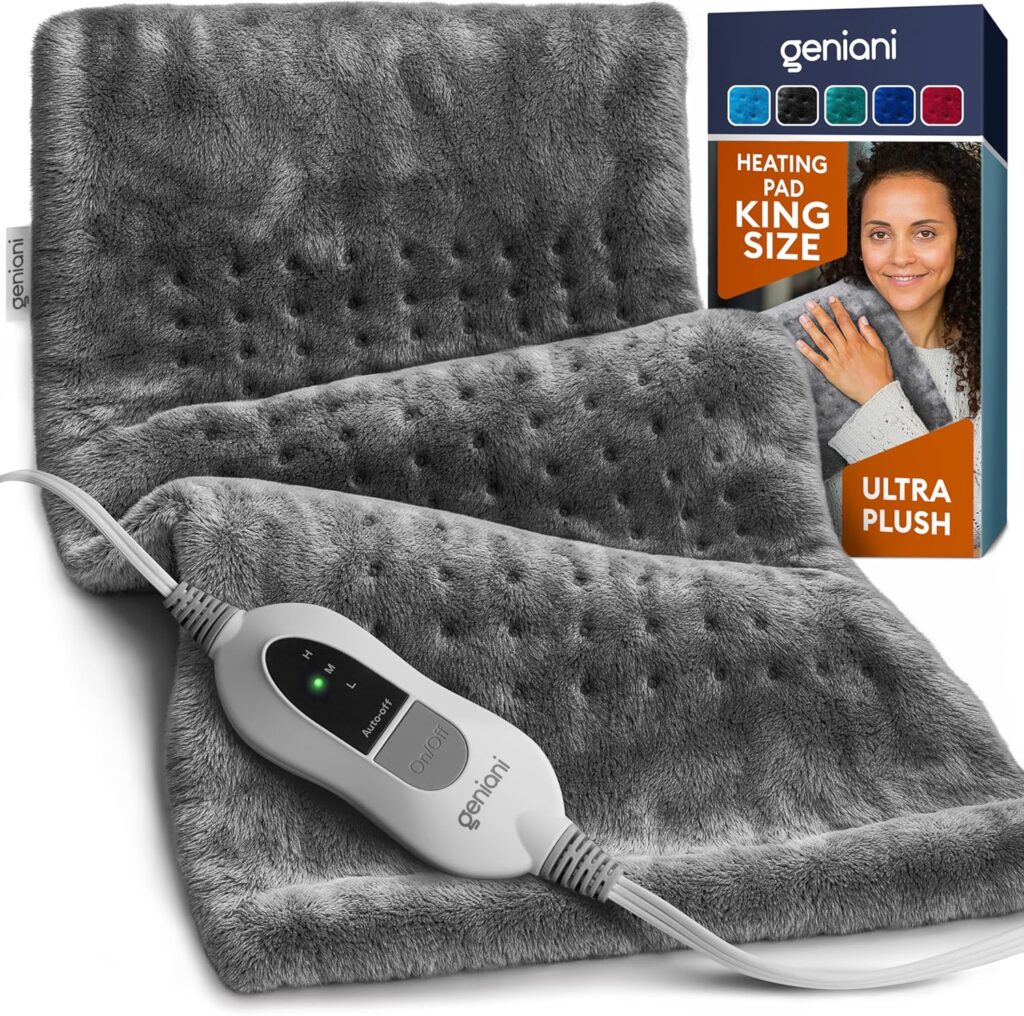
Heat therapy is great for relaxing tight muscles and improving blood flow. A heating pad is a simple yet powerful tool that eases pain and stiffness in your lower back.
Benefits:
- Soothes sore muscles
- Promotes faster healing by increasing circulation
- Adjustable temperature settings for comfort
Best For: Use during rest periods, especially in the morning or before bed
🛒Click here to see it on Amazon ➜ Heating Pad
3. Foam Roller for Lower Back and Core
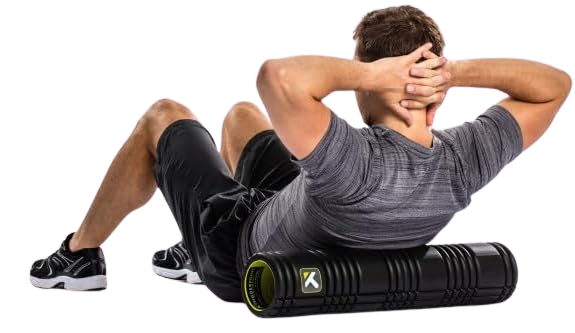
A medium-density foam roller helps release tension and break up muscle knots. While you shouldn’t roll directly on the spine, foam rolling around the hips and glutes can relieve lumbar pressure.
Benefits:
- Improves flexibility and mobility
- Reduces tightness in hips and back
- Aids in active recovery routines
Best For: People who sit often or have tight glutes/hip flexors
🛒Click here to see it on Amazon ➜ TriggerPoint GRID Foam Roller
4. TENS Unit for Muscle Pain Relief

A TENS unit (Transcutaneous Electrical Nerve Stimulation) sends small electrical pulses to the muscles, blocking pain signals and promoting relaxation.
Benefits:
- Reduces muscle spasms
- Drug-free pain relief
- Portable and easy to use at home or work
Best For: People with ongoing back spasms or nerve-related pain
🛒Click here to see it on Amazon ➜ iRelieve TENS Unit
5. Lumbar Support Cushion for Sitting
If you sit for long hours, a lumbar support pillow is a must-have. It helps maintain the natural curve of your spine and reduces pressure on strained muscles.
Benefits:
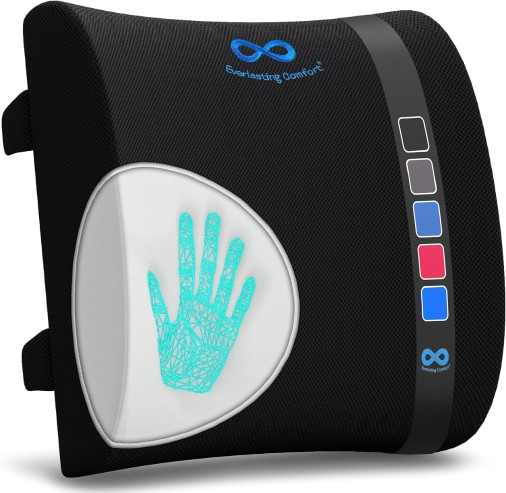
- Encourages proper posture
- Prevents slouching while sitting
- Lightweight and easy to use in office chairs or cars
Best For: Office workers, drivers, or anyone recovering while seated
🛒Click here to see it on Amazon ➜ Lumbar Cushion
💡 Quick Tip:
Always choose lumbar strain recovery tools that fit your body size and pain level. Consult your physical therapist for guidance when in doubt.
🎯 How to Choose the Right Lumbar Support Tools
With so many products available, it can be hard to know which lumbar strain recovery tools actually work. The right tool depends on your symptoms, daily routine, and stage of recovery. Here’s a simple guide to help you choose wisely.
🧩 1. Match the Tool to Your Main Symptom
Ask yourself:
- Is the pain sharp or dull?
- Do I have tight muscles or poor posture?
- Am I sitting or standing most of the day?
| Symptom | Recommended Tool |
|---|---|
| Muscle tightness | Heating pad, foam roller |
| Poor posture | Back brace, lumbar cushion |
| Nerve pain or spasms | TENS unit |
| Pain during movement | Adjustable brace or compression |
📐 2. Look for Adjustable and Ergonomic Features
Choose tools that can be adjusted to your size and needs, especially if you’re using them daily. For example:
- A back brace with adjustable straps fits more comfortably
- Heating pads with timer settings offer safer use
- Cushions with memory foam conform better to your back shape
💡 Tip: Avoid “one-size-fits-all” products—they often don’t offer enough support for lumbar strain recovery.
🔋 3. Consider Portability and Ease of Use
You’re more likely to stick with a tool if it fits into your lifestyle.
Look for:
- Lightweight, travel-friendly options
- Rechargeable devices like portable TENS units
- Easy-to-clean materials for hygiene
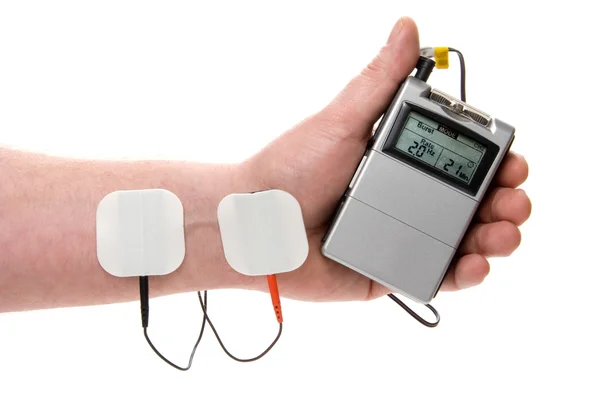
🧑⚕️ 4. Choose Tools Backed by Experts
Always check for:
- PT or chiropractor recommendations
- Verified reviews from people with back pain
- Medical-grade certifications (especially for braces or devices)
💡 Pro Tip: Look for tools tested in clinical settings or approved by health professionals—they’re more likely to give real results.
🛒 5. Don’t Overbuy—Start with 1–2 Essentials
Many people only need two core lumbar strain recovery tools:
- A support item (brace or cushion)
- A pain relief item (heat, foam roller, or TENS unit)
Once you see what works, you can add more tools based on your progress.
⚠️ What to Avoid During Lumbar Strain Recovery
(Top Mistakes That Slow Down Healing)
Even with the right lumbar strain recovery tools, progress can stall if you’re making common recovery mistakes. Here are the top 3 things to avoid:
❌ 1. Doing Too Much, Too Soon
Pushing through pain or jumping into stretches and workouts too quickly can worsen a lumbar strain. Your body needs time to heal before returning to regular activity.
Avoid:
- Heavy lifting in the first 3–5 days
- High-impact exercises like running or twisting
- Ignoring sharp pain signals
✅ Do this instead:
- Rest for the first 48–72 hours
- Use a back brace, ice pack, or TENS unit for relief
- Slowly reintroduce movement using PT-approved exercises
❌ 2. Sitting or Lying Down Without Proper Support
Prolonged sitting or poor sleeping positions put strain on healing muscles and ligaments.
Avoid:
- Slouching in office chairs or cars
- Sleeping flat without a pillow under your knees
- Skipping lumbar support when sitting for long periods
✅ Do this instead:
- Use a lumbar cushion to support your spine
- Take standing breaks every 30–45 minutes
- Try a reclined or side-sleeping position with a pillow for alignment
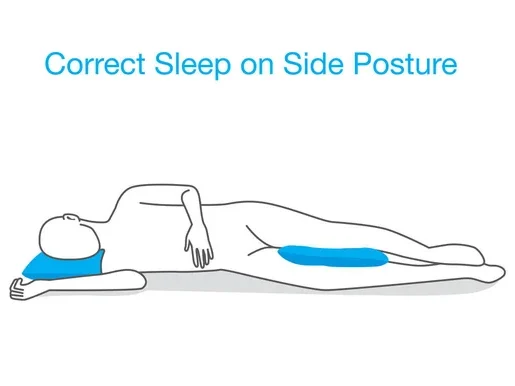

❌ 3. Using the Wrong Tools—or None at All
Using poorly made or improperly sized support tools can delay healing, and doing nothing at all can lead to a longer recovery period or reinjury.
Avoid:
- “One-size-fits-all” braces without adjustable features
- Heating pads with no auto shut-off
- Cheap cushions that flatten easily
✅ Do this instead:
- Choose lumbar strain recovery tools with expert reviews or PT backing
- Pick adjustable braces, ergonomic cushions, and portable TENS units
- Start with 1–2 essentials, like a brace + heating pad or foam roller
❓ Frequently Asked Questions (FAQ)
1. How long does it take to recover from a lumbar strain?
Most mild to moderate lumbar strains heal within 2 to 4 weeks, especially with the right care. Using the proper lumbar strain recovery tools—like braces, heating pads, or TENS units—can speed up the process and reduce discomfort.
Severe strains or repeated injuries may take longer and may require physical therapy.
2. Do I need a back brace for a lumbar strain?
A back brace isn’t always required, but many physical therapists recommend it during the early stages of recovery. It helps:
- Support your spine
- Prevent further injury
- Improve posture while sitting or moving
Look for adjustable braces that offer lumbar support without being too restrictive.
3. Can I exercise while recovering from a lumbar strain?
Yes—but timing and intensity matter.
In the first few days, focus on rest and pain relief using cold therapy and support tools. After that, begin with gentle stretches like pelvic tilts and child’s pose. Avoid high-impact or twisting movements until your pain is mostly gone.
For best results, pair stretching with recovery tools like a foam roller or lumbar support cushion.
📢 Before you go! Sign up below for weekly home recovery tips, injury rehab advice, and therapist-approved gear reviews straight to your inbox!!



